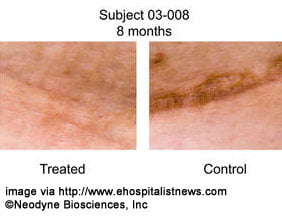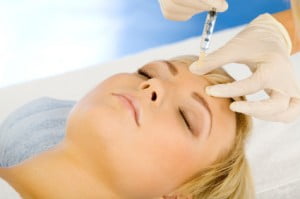 Cosmetic surgery sometimes leaves you with an unwanted reminder of the procedure — a scar. Now a newly developed bandage shows promise for reducing scarring after tummy tuck surgery based on study results of a small group of patients.
Cosmetic surgery sometimes leaves you with an unwanted reminder of the procedure — a scar. Now a newly developed bandage shows promise for reducing scarring after tummy tuck surgery based on study results of a small group of patients.
Published in the Annals of Surgery, results showed a statistically significant difference in the ratings of the scars by both plastic surgeons and lay people between the treatment and the control group, with the treatment group getting better ratings for scar appearance.
Plastic surgeon Dr. Geoffrey C. Gurtner, who developed the bandage, said, “In none of the cases was the treated scar worse than the control scar, which I think is different than some of the biologic agents we’ve seen over the last few years.”
Gurtner and his colleagues created the bandage so that it isolates the wound from the movement of the skin around it. One reason scars form is that skin movement around the incision pulls at the new skin tissue that is growing as the wound heals, causing the scar tissue to thicken and spread out.
The incision is covered by the bandage, which is held on by adhesive strips that run parallel to the wound. Gurtner said that they transfer the stress of movement away from where the skin is growing back together.
The bandage could be used for more than just scars from cosmetic surgery. For example, Gurtner reported there is interest in it from orthopedic surgeons who perform knee replacements.
Scar Reduction Options
Options for reducing scars include:
- Topical treatments, such as gels, tapes or external compression, which can help in wound closure and healing.
- Injectable treatments, which can be used to fill depressed or concave scars.
- Surface treatments, which can reduce uneven pigmentation and soften surface irregularities; options include dermabrasion, laser resurfacing, chemical peels and skin bleaching agents.
 The benefits of fighting wrinkles with Botox may not be greatly diminished by decreasing the frequency of treatment, according to a study by the Oregon Health & Science University’s Casey Eye Institute that looked at how often to get Botox.
The benefits of fighting wrinkles with Botox may not be greatly diminished by decreasing the frequency of treatment, according to a study by the Oregon Health & Science University’s Casey Eye Institute that looked at how often to get Botox.
When looking at a group of 50 women, aged 30 to 50 who were being treated for glabellar lines, the study found a decrease in treatments did not yield a decrease in results. The study discovered that after a patient has undergone regular Botox treatments every four months for two years, the frequency can be lowered. The frequency of how often to get Botox may not dramatically effect its effectiveness.
In fact, the study found that patients who had completed the initial two-year treatment and then received Botox injections only every six months achieved similar results. This is when compared to those who continued receiving Botox treatments every three months.
Though Allergan, the maker of Botox, may still recommend continued treatment every three months, those looking for a cost-effective alternative could reduce the number of yearly treatments.
As an added benefit, the study found that the patients in the age group also experienced a reduction in the formation of wrinkles when Botox use was continued past two years.
 Mad Men actress Christina Hendricks is the newest celebrity spokesperson for Latisse®, which has kicked off its second Wishes Challenge. The actress is encouraging women to join her in the challenge to raise $500,000 for the Make-A-Wish Foundation, which is dedicated to granting the wishes of children with life-threatening medical conditions.
Mad Men actress Christina Hendricks is the newest celebrity spokesperson for Latisse®, which has kicked off its second Wishes Challenge. The actress is encouraging women to join her in the challenge to raise $500,000 for the Make-A-Wish Foundation, which is dedicated to granting the wishes of children with life-threatening medical conditions.
If you’re one of the first 10,000 people who donate a minimum of $20, you’ll receive a certificate for a free trial of Latisse®, which you can take to your cosmetic surgeon who will determine if the eyelash enhancer is right for you. In addition, you can get a $20 rebate off your next purchase of Latisse® if you invite two friends to join you in the campaign.
Allergan, the makers of Latisse, will double any donation up to a total of $250,000 until November 30, 2011; you can donate at www.LatisseWishesChallenge.com.
Follow Hendricks on her Latisse® Journey
Throughout the campaign Hendricks will be sharing her experience with using Latisse® on her lashes.
“I’ve always felt my lashes were short and thin, and in my profession, I wear a lot of false lashes and makeup, which take a toll. So when Latisse® became available, I was curious to learn more,” she said. “My doctor talked with me about lashes, and I was surprised to learn that some women may notice their lashes thinning over time. Women who notice these changes in their lashes now have the option to talk to their doctor about Latisse® and see if it’s right for them.”
Apply Latisse® daily to your eyelashes to grow them longer, fuller and darker. The results will last as long as you continue to use Latisse®.
There’s a new twist on the mommy makeover, which usually features a combination of cosmetic procedures that help mothers restore their bodies to its pre-pregnancy state. However, the latest incarnation combines a cosmetic procedure and a medical one.
ABC News in San Francisco reports that an ob-gyn and a plastic surgeon have teamed up to perform a pelvic sling procedure to correct bladder issues that arise after pregnancy and a tummy tuck to remove excess skin and fat from the abdomen and tighten the abdominal muscles.
ABC interviewed one mom who said her two pregnancies took an embarrassing toll on her body. “Every day you have to wear these thick pads so that you stay dry. Going down the steps, picking up your child from the car seat, a little bit of exertion you get wet,” she explained.
Rather than having her bladder issue fixed with conventional surgery, she decided on the combination procedure. “I know I’ll never be the same as before I had the children, but I think it will be spirit lifting,” she said.
Dr. Carolyn Chang, who has performed tummy tucks after the pelvic sling procedure at California Pacific Medical Center in San Francisco, said, “I like to call this the ultimate mommy makeover.”
The bladder procedure takes about a half hour, after which Dr. Chang performs the abdominoplasty.
Risks & Benefits
There are always risks to surgery, and one of the downsides of combining procedures is a longer time in the operating room and a potentially more complicated recovery if there are problems with either surgery.
However, there are some possible benefits to combining the procedures. The costs could be lower, because while the tummy tuck isn’t covered by insurance, some shared expenses — such as anesthesia and the recovery room — may be. Another possible advantage is that the patient will have a single recovery time for the two procedures.
Psychologically it could make going under the knife easier as well. “You’re doing a surgery that you want with a surgery that you medically need and that makes having surgery in general much more palatable,” said Dr. Chang.
 When Bristol Palin recently debuted a new look that included a more angled jaw and defined chin, it sparked media reports and speculation about what procedures she had done to achieve it.
When Bristol Palin recently debuted a new look that included a more angled jaw and defined chin, it sparked media reports and speculation about what procedures she had done to achieve it.
Palin told US Weekly magazine she had corrective jaw surgery, not cosmetic surgery. Palin said she had her surgery so her jaw and teeth could properly realign and that she is pleased with her new look.
Still, her transformation has created interest in chin surgery.
Chin surgery, which is also referred to as mentoplasty or chin augmentation, balances a person’s face by adding projection to the chin. A custom implant is inserted in front of the jawbone during the surgery.
There are also other options for improving the look of the chin area. For instance, a concave chin could be corrected with dermal fillers by temporarily building out the chin. Other facial implants, such as cheek or jaw line implants, also offer ways to add volume to the face.
The Washington Post asked an oral and cosmetic facial surgeon’s opinion on Palin’s look, and he believes she did undergo “some procedure on her chin … It also appears as if she has had liposuction under her jaw.”
However, Palin said that she wouldn’t consider plastic surgery unless she was in an accident or got disfigured.
Whether it was corrective, cosmetic or a combination, Palin is happy with her look. She told US Weekly, “I am absolutely thrilled with the results. I look older, more mature, and don’t have as much of a chubby little baby face!”
 There are a range of choices you’ll make with your surgeon if you’re considering breast augmentation, including cup size, implant type (saline vs. silicone) and where your surgeon will make the incision.
There are a range of choices you’ll make with your surgeon if you’re considering breast augmentation, including cup size, implant type (saline vs. silicone) and where your surgeon will make the incision.
For a breast augmentation, the incision techniques include:
- the crease of the lower part of the breast
- along the lower half of the areola
- in the armpit
- through the belly button
A transumbilical breast augmentation (TUBA) is one in which the incision is made through the belly button, and because the incisions are hidden in the navel, it is sometimes referred to as scarless breast augmentation.
According to Cosmetic Surgery Times, a review of 3,300 charts of TUBA cases emphasizes the assertion of Dr. Robert Shumway that it is a “faster, safer and better procedure than other breast augmentation approaches.”
Dr. Shumway, who reported on his own TUBA procedures at the 27th annual American Academy of Cosmetic Surgery scientific meeting, said that “TUBA is about as safe as breast augmentation can get.”
At the meeting he reported on complications, complaints and patient satisfaction ratings from the TUBA procedures he did between 1994 and 2010.
The most common complication Dr. Shumway saw was capsular contracture (69 cases, 2.09 percent), and he said the rate is lower than the published national average for augmentations performed via other techniques.
He also found that there was one possible infection (0.03 percent) and only several other types of complications, all with rates equal to or less than 0.18 percent.
On a scale of one to 10, patient satisfaction ratings at two and six months after surgery were eight or higher, with a mean of 9.7, he said.
Dr. Haiavy was one of the first cosmetic surgeons in the United States and Southern California to perform transumbilical breast augmentation, which results in no visible scars, reduced loss of sensation and reduced risk of infection.
Latisse, with its famous spokespersons that include Brooke Shields and Claire Danes, has become well-known as an eyelash enhancer since it was approved by the FDA in 2008 for use on the top lashes. What you may not know is that some are using it to regrow other hair as well, as some doctors prescribe it for hair and eyebrow loss that has not responded to other treatments.
Good Morning America highlighted the drug’s off-label uses, including a bride-to-be who wanted fuller eyebrows. Dana Gaiser, 27, regretted overly plucking them during her teenage years, and when she saw ads for Latisse, she thought it might be her solution.
Although her doctor was reluctant at first, Gaiser was persistent and got the prescription. Gaiser said she noticed new hairs around her brows within six weeks of starting the treatment. “I had had this one spot on my right eyebrow that would never grow,” she said. “But I put Latisse there and now it’s back.”
Latisse is also sometimes being used to treat baldness.
Hair restoration specialist Dr. Alan Bauman told GMA that he prescribes it for some patients for hair loss. For Dr. Bauman’s patient Richard Paduda, Latisse seemed to stimulate the follicles for his head hair.
“It feels great. I got some of my hair back,” Paduda said. “I was worried about losing it, and it started coming back.”
Dr. Bauman said he’s seen similar results in 70 percent of his patients, but he pointed out its limitations. “This is not a miracle cure. This is mainly for patients who still have some thin, wispy hair left,” he said
Allergan, the maker of Latisse, is currently planning clinical trials to evaluate bimatoprost, Latisse’s active ingredient, for male and female pattern baldness.
 Just in time for Mother’s Day, a new survey shows that today’s moms want their pre-baby bodies back and are open to cosmetic surgery to get there.
Just in time for Mother’s Day, a new survey shows that today’s moms want their pre-baby bodies back and are open to cosmetic surgery to get there.
The survey by the American Society of Plastic Surgeons showed that 62 percent of mothers said they would consider a “mommy makeover,” which includes procedures such as a tummy tuck, breast augmentation and/or breast lift, if cost were not an issue.
“In the last decade we’ve seen women’s attitudes about cosmetic surgery change. Today women are not afraid to admit that they love their children, but they wish their bodies looked the way they did before their first pregnancies. And they’re not afraid to acknowledge that they may need a little help beyond a healthy diet and exercise,” said plastic surgeon Phillip Haeck, MD.
Another trend that surgeons are seeing is that patients seeking a mommy makeover are younger than a decade ago.
“In the past we saw a lot of women in their 50s getting these types of procedures. But today we are seeing young mothers in their 30s coming in for procedures such as tummy tucks and breast lifts,” said Dr. Haeck. Moms today want their pre-baby bodies back now, he said.
Dr. Allen Rosen, a plastic surgeon, agrees and said because women today talk more openly about procedures, cosmetic surgery is more accepted than it was just ten years ago.
If you’re considering a mommy makeover, here are some general tips from the survey:
- Wait at least six months to a year after having your last child before undergoing mommy makeover procedures.
- Be specific about your post-baby body goals so that your cosmetic surgeon can recommend the best procedures for you.
- If you are trying to lose weight, do so before undergoing the procedures.
Inland Cosmetic Surgery currently has specials in honor of Mother’s Day, including savings on certain combinations of mommy makeover procedures through May 31, 2011.
 Does getting Botox inhibit our ability to read others’ facial emotions? It might, according to a new study published in Social Psychological and Personality Science that found that people who had Botox injections were significantly less accurate at reading others’ emotions in photos compared to those who had Restylane injections.
Does getting Botox inhibit our ability to read others’ facial emotions? It might, according to a new study published in Social Psychological and Personality Science that found that people who had Botox injections were significantly less accurate at reading others’ emotions in photos compared to those who had Restylane injections.
Despite the findings, it’s important to note that even the study’s author David R. Neal, PhD, a psychology professor at the University of Southern California, admitted that it’s a “fairly subtle” effect.
The study found that women who had their facial folds treated with Restylane were able to read others’ emotional states with about 77% accuracy, while those who had Botox had 70% accuracy.
Why would Botox have this effect and not other fillers? According to Neal, evidence suggests that people use mimicry to register and label the emotional states of others, so something that limits one’s ability to reproduce another person’s expression of emotions, such as Botox — which has a paralyzing effect on facial muscles in the immediate vicinity of the injection site — would likely impair one’s ability to register or label those emotions.
Andrew Jacono, MD, a facial plastic surgeon in New York City who reviewed the study, said that the findings likely only apply to those who use excessive amounts of Botox.
“When Botox is overdone, it doesn’t look right and people aren’t perceived in the right way,” Jacono said. “The goal is to try to make sure when you get Botox, it is done in a subtle way so you can look better and maintain your ability to emote and read others.”
A recent episode of The Doctors featured “Ask Our Doctors: Celebrity Edition,” and actor Blair Underwood inquired if there is a cosmetic surgery procedure that can give a man six-pack abs.
Plastic surgeon Dr. Andrew Ordon explained that VASER liposuction is a possible solution. “He’s not alone, and we do have a surgical solution. Liposuction has come such a long way. There’s a new technique called VASER, or as I call it, super-charged lipo.”
VASER liposuction not only sucks out the fat, but it first melts fat cells, which allows the doctor to remove more fat cells evenly, with less discomfort and less bleeding. When the fat cells are removed, the skin has a natural ability to shrink down.
Ordon goes on to explain that for the six-pack procedure, the surgeon can use the VASER instrument to perform a technique called etching, in which the six-pack lines can be etched out.
VASER liposuction is offered at Inland Cosmetic Surgery of Rancho Cucamonga and compared to traditional liposuction, it usually has a reduced recovery time. VASER can be used on many areas of the body, including the abdomen, arms, back, hips, knees, love handles, neck and chin, saddlebags and thighs.
Learn more about the differences between traditional liposuction and VASER liposuction.